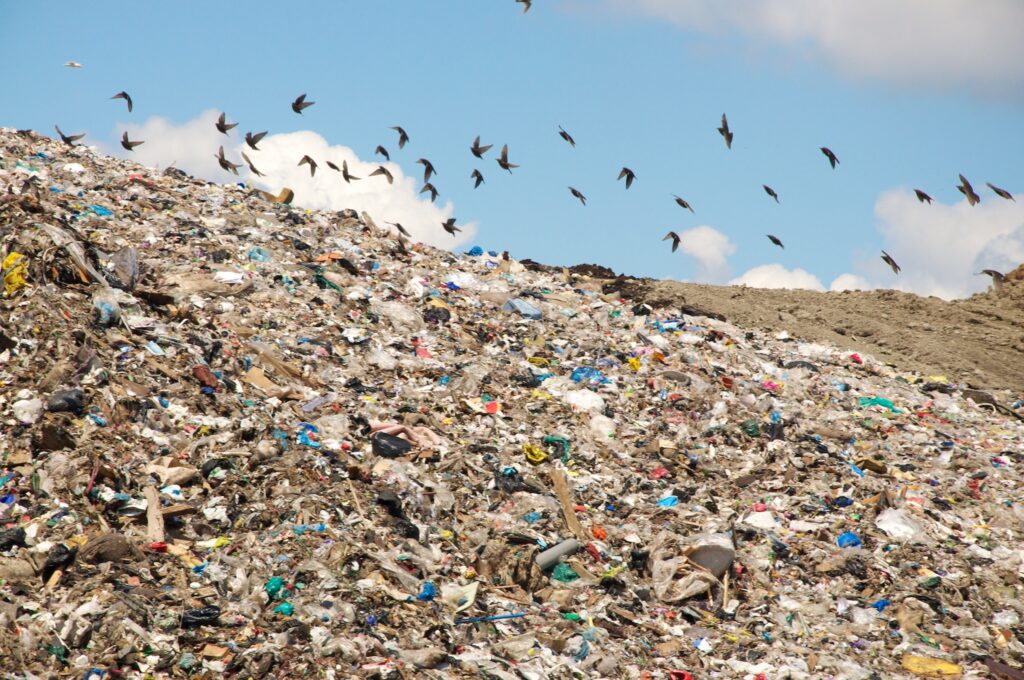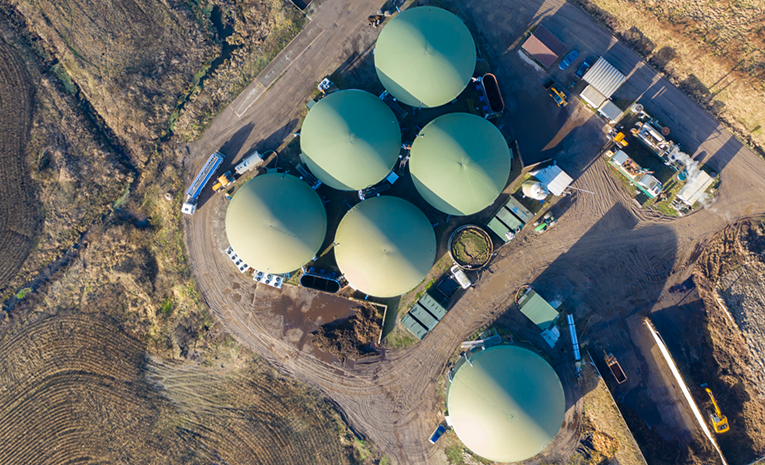GHD is advancing No Time to Waste, an initiative and call for governments to act on this matter and harness a golden opportunity in today’s global economic panorama.
As the world strives to become more sustainable and reduce the environmental footprint of industrial activities, innovative solutions that allow green sources of energy and tackle a global problem like waste management are more relevant than ever.
In this regard, solutions like Renewable Natural Gas (RNG) and Hydrogen are becoming vital elements of the energy transition and cross-sector solutions. These energy sources can deliver clean fuels for transportation, heating, power generation, and other industrial activities.
Consequently, projects like producing energy from landfills and dairies are becoming central to governments’ and municipalities’ strategies to reach net-zero. However, developing projects like these can be costly and frequently faces many hurdles in regulation, policy, and financing. That’s why GHD, a leading company offering engineering services in the markets of wastewater treatment, waste-to-energy, buildings, etc., is advancing No Time to Waste, an initiative and call for governments to act on this matter and harness a golden opportunity in today’s global economic panorama.
To speak about it, Margaret Zuckweiler, Waste Management Service Line Leader for the Americas, GHD, sat with us on an exclusive interview.
Can you please describe in general the services that GHD offers?
MZ: Our services strategy is focused on five pillars, in which RNG is under our Environmental pillar, but it also crosses over our Energy & Resources pillars. The five pillars of our strategy are Transportation, Environment, Buildings, Energy & Resources, and Waste Water. Each of those pillars addresses different industries, but they also crossover.
These five pillars are all working in decarbonization in some way?
MZ: Environment does. But I think all pillars do that where it’s applicable. In our case, the RNG space is an obvious connection with decarbonization strategies. But when we are doing remediation activities, we are trying to bring those facets that can advance these initiatives, when applicable. Sometimes the work doesn’t necessarily bring itself to decarbonization. But when talking about Energy & Resources, for sure it does. However, we also do traditional work in the oil and gas space.
In GHD’s experience, what is the most difficult part of decarbonization of energy systems?
MZ: We have been in the landfill gas business for quite some time, decades… We have also been handling organic waste management for over 15 years. Those two meet in the middle with RNG. Four years ago, we started doing quite a few feasibility studies to determine whether or not it made sense for a particular entity to develop an RNG project. And what we have seen as fundamental barriers are economics: whether it is economically feasible for a specific company in its particular geography to develop the project. The feedstock is another potential barrier. Also, sometimes RNG projects require a lot of existing infrastructure. Sometimes, in particular cases, that infrastructure is not there and needs to be developed; that is also a barrier. If the infrastructure is there, that makes it much easier.


How does Renewable Natural Gas fit into the energy transition?
MZ: Let me start with what RNG is. Renewable Natural Gas is essentially methane that’s cleaned up and acts just as natural gas in your pipeline. However, the RNG source can come from multiple different areas. For example, we can clean up landfill gas into RNG. Animal waste can also become RNG through anaerobic digestion.
Specifically, from dairies, there’s a lot of RNG coming through. Yet another source is biosolids from wastewater treatment facilities. All of those things that we take as waste goes through anaerobic digestion for decomposition. All of that resource if it is not collected, is lost. But if you collect it and upgrade it, and put it in a pipeline, that becomes a resource. And that is where RNG meets decarbonization efforts by using a resource that would otherwise go to waste. Also, the methane that would otherwise go into the atmosphere is collected, gathered, and used as an energy resource.
Why is it important to develop waste-to-energy solutions?
MZ: We all produce waste in multiple facets. If we just let it go as the population increases, we would have a severe waste issue. But if we collect it and use it as a resource, we essentially complete the circular economy model. We generate, take, and put it back into what we use, versus leaving the waste over a landfill. Ultimately, that is a real benefit for us regarding climate change and decarbonization.
On the other hand, RNG is a solution because of the Low Carbon Fuel Standard (LCFS) and other credits available to develop those projects. RNG projects can be expensive, but when you have funding, and returns like the LCFS provides, you have an available resource to reduce the environmental footprint of certain industries.


How does GHD is collaborating with the industry to unlock the potential of RNG?
MZ: We work with developers, technology providers, municipalities, and private entities interested in working and building these types of projects. What they are asking us to do is, first of all, do feasibility studies. What feasibility shows is whether or not a particular project will be profitable. We also work with technology providers. GHD is technology-agnostic. So what we do is match the technology to the type and specific needs of a certain project. We determine what will work; ask developers to bring their prices to us, then present it to the client. We also develop projects along with partners. One of our partners right now is the city of Toronto, where we are developing RNG projects. We design, help build, and overall support the project through commissioning and operation.
Is there any success story of GHD in regards to the relevance of RNG in a decarbonized economy?
MZ: As I mentioned, the city of Toronto has been a partner for us. We have been helping the city to develop anaerobic digestion facilities, where the city will be able to process organics to produce biogas. The biogas will then be collected and upgraded through the RNG technology to put it back in the pipeline for use.
What are the main hurdles or challenges right now in regards to launching wide projects to harness or produce power from waste?
When you are talking about RNG development, the cost is definitely one of the main challenges, as I said before. Regulation can also be a big hurdle. But it can also be an enabler if regulations and policies encourage these projects. The specific project requirements can also be a challenge, as these projects are new and sometimes people are not necessarily well versed in what they need.
When we are talking about something like dairies, the animal waste typically goes to lagoons or wide-open spaces that hold the waste. When you have a project to use that waste you got to have a covered lagoon or a facility, which can be expensive. Sometimes, to make a project viable, you need more than one dairy farm to have an anaerobic digestor installed. Then you put those pieces together with the pipeline, the biogas upgrading system. Then you have to install the pipeline to the location where the RNG is going to be used.


Can you explain what the No Time to Waste Strategy is?
MZ: No Time to waste is really a white paper that combinates all of our experience with organics management and anaerobic digestion, and biogas into RNG; our experience with developing these projects long term, and also our experience with wastewater treatment plants that propose co-digest, which means bringing different feedstocks. The purpose of No Time To Waste is essentially a call to say: this is important, this is what we can do to use waste as a resource, and these are steps and the things to consider when you want to develop a project. The ultimate thing to consider is why you want to. No Time To Waste is fundamental Why. Why you want to use waste as a resource. The aim is that fundamental decarbonization piece where is important to use our existing resources to reduce our impact on this earth.
Can you explain how this strategy will seize opportunities coming out from new regulations, and the COP26’s goal of wide decarbonization?
MZ: Decarbonization is one of the main goals of the COP26. You take waste that is not carbon-friendly, waste that generates a lot of methane… but you then flip the script and you make that waste a decarbonization source. That is ultimately the fundamental reason why you want to do this.
Finally, RNG is part of the net-zero goals. A lot of municipalities, a lot of entities across the globe are making decarbonization and net-zero by 2050 a goal. I think that GHD is questioning if net-zero is enough, or the real goal should be net-negative, where we improve things instead of leaving them as they are. In this regard, RNG is a piece of several others. Hydrogen is another way. In fact, GHD has also a hydrogen group that is doing research and moving forward projects of this sort. Hopefully, soon we will reach the net negative goal.


